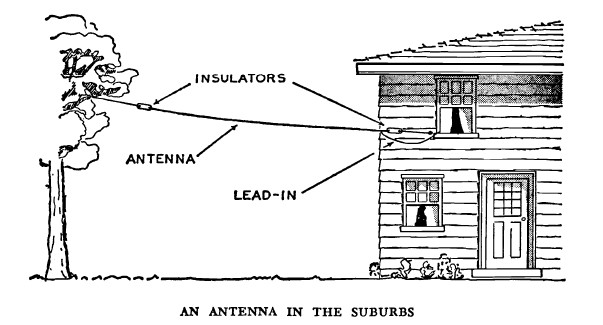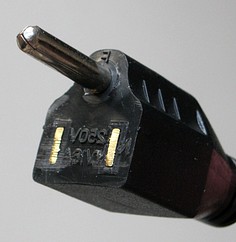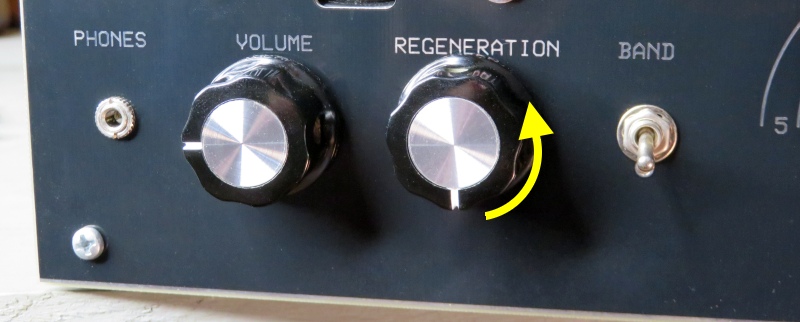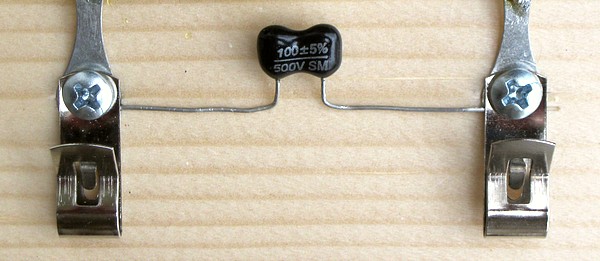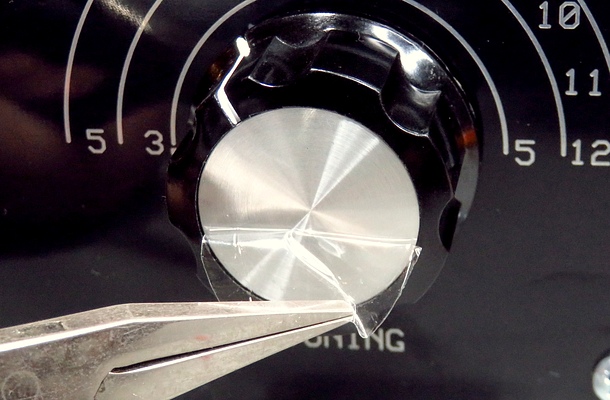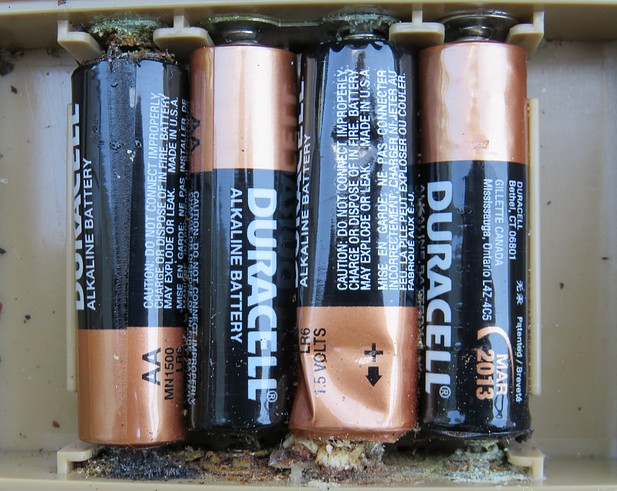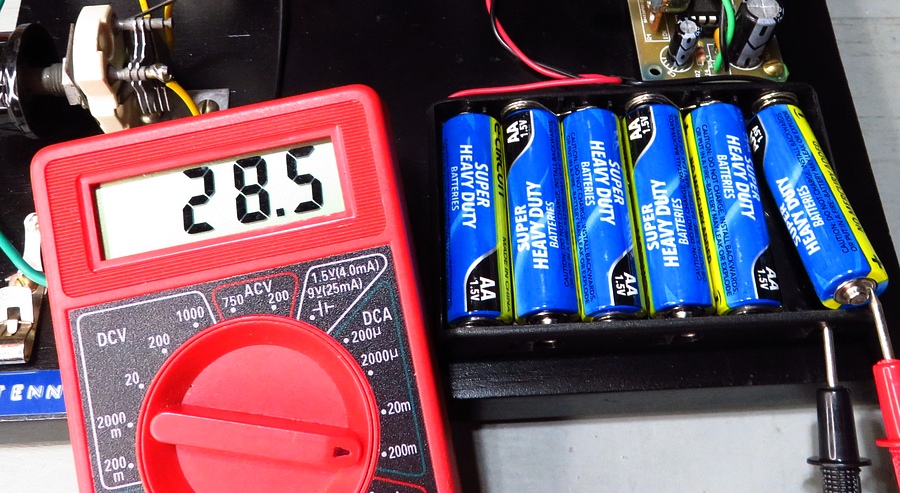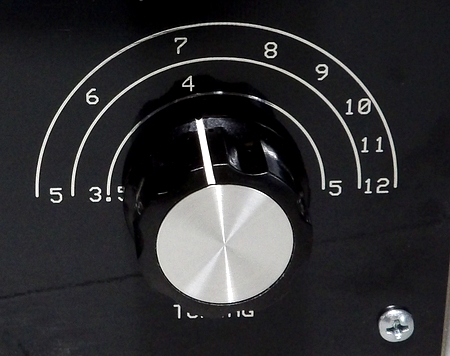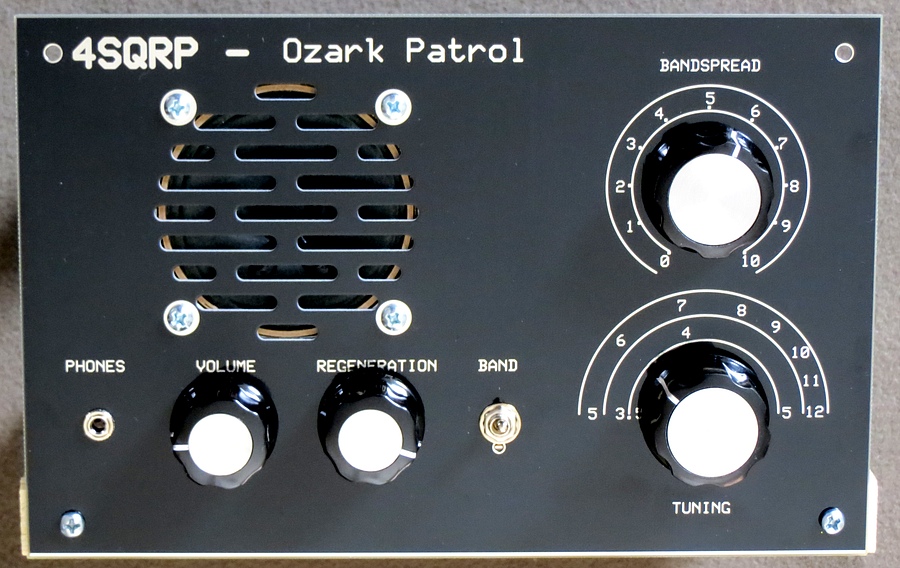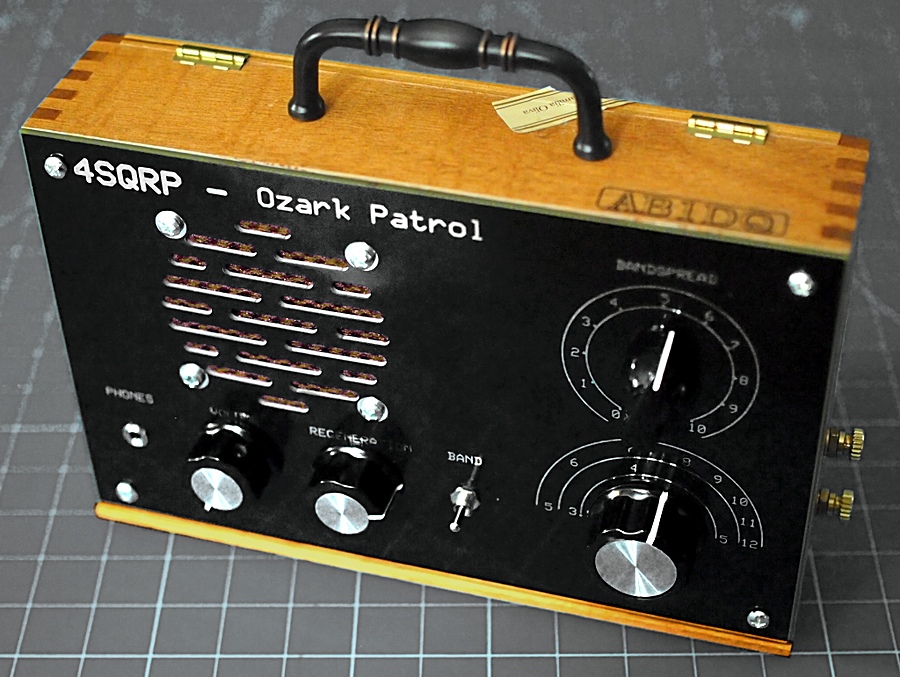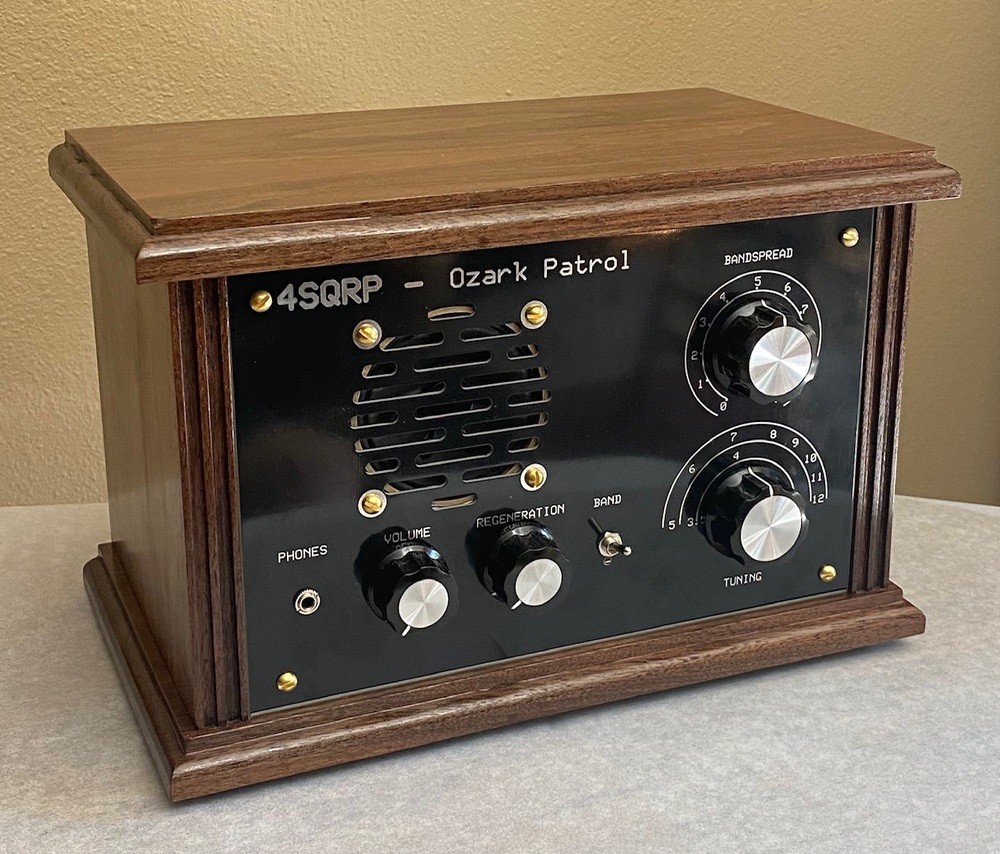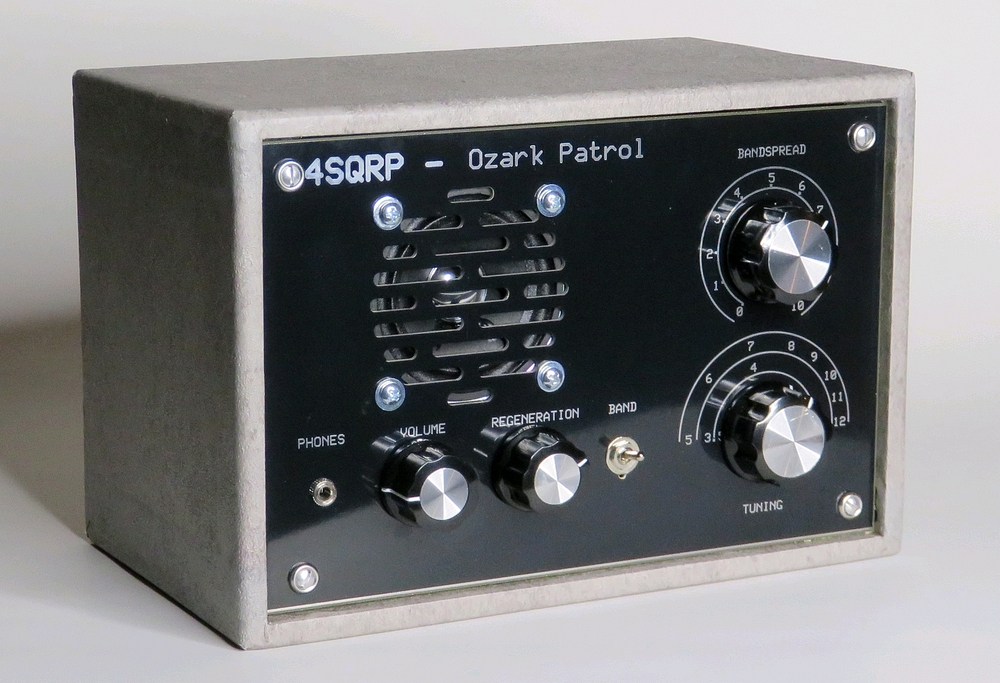 |
The
OZARK PATROL |
 |
|
|
|
|
A demo of the radio. Sloppily tuned. I was trying
to tune everything and nothing just to show what it is capable of.
The antenna is 100' of hook-up wire going up to the attic. An
outside antenna would work better. |
|
|
In conclusion, the Ozark Patrol is a great little
regen kit that performs well with headphones or an added amplifier
for speaker operation. |
|
|
A few tips |
|
|
|
| Tip 1: |
The instructions say to connect an
antenna to the radio. What kind of antenna? It's just a
piece of wire! How long should it be? 65 feet is a good
length for reasons we won't go into here. If this isn't
practical, just try to get as much wire in the air as
possible, preferably outside.
|
|
|
|
|
|
|
|
|
|
|
|
| Tip
2: |
This radio needs
an earth ground to work properly. Without the earth ground
the signals are weak. If you can't easily connect to a ground
you can pick one up using an old computer or printer cord. Cut the blades off
with a hacksaw, leaving the ground prong. Make sure you
have the correct color wire, and cut off the other two wires. Now
just plug it in, and you have a ground wire.
|
|
|
|
|
 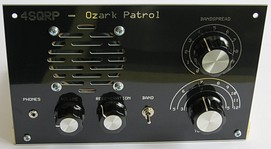 |
| Tip
3: |
You've just finished the radio,
you've turned it on and you hear... nothing. Or, you hear
one station, and that's it. Look out the window. Is the sun
up? Some of the shortwave bands are basically stone dead at
certain times of the day. Try again as the sun is setting.
There is nothing to be heard on the lower band (3.5 to 5
MHz) during the day, but you can pick up some hams around
sunset. The upper band will come to life around the same
time, but you should be able to get something on it all day.
|
|
|
|
|
|
|
| Tip
4: |
The radio is acting strange. You hear
signals but can't seem to tune them in well. The regen
control in the Ozark Patrol has a reverse action. Turn
it fully clockwise (no regeneration), then slowly turn it
counter-clockwise. Stop when you hear the hiss, and back it
off a tiny bit. The radio is most sensitive right before it
breaks into oscillation. |
|
|
|
|
|
|
|
|
| Tip
5: |
You tune in a station, move your
hands off the knobs and, "Vweerp!" the station vanishes. You
put your hands near the radio and "Vwoop!", it comes back.
This is caused by "hand capacitance." Basically, the radio
is emanating an electrical field and your hands are
disturbing it. I
was able to cure this by putting a small value capacitor
between the antenna and ground lugs. I don't know why this
works, but it does. The value I used was 100 pF.
|
|
|
|
|
| Tip
6: |
Consider putting some feet on your Ozark patrol so
that air can circulate under it. This may sound like a crazy
reason for adding feet but you'll be glad you did years from
now, when you find it stashed on a shelf and
the base hasn't warped.
|
|
|
|
| This radio just happens to have
a pine base that is the exact same size as the one on
the Ozark Patrol. The
top side absorbed moisture from the humidity in
the air, while the underside had no air circulating under
it. |
|
|
|
|
|
|
|
|
|
| Give the base a coat of polyurethane, lacquer, or paint before
assembling the radio. I ended up painting the base, but I
had to take it apart first. I considered replacing the base
with Masonite, but it would be front heavy and tend to
topple over if the batteries were removed. |
|
|
|
|
|
|
|
|
| Tip
7: |
You might see
that one of the knobs arrived with a big scratch on the
front. The silver inserts on the knobs have a
clear piece of plastic protecting them. The scratch is in
the plastic. Just peel it off. |
|
|
|
|
|
|
|
|
| Tip
8: |
Never
use
DURACELL AA alkaline batteries. They leak. The
company knows they leak, and has known for years but won't fix
them. Sometimes you'll find them leaking in the pack while still in the
store. The Duracell batteries in the photo above ruined a remote
control toy tank. The corrosion travelled from the
battery contacts to the circuit board and dissolved the
traces on the board.
The second battery from the left looks OK. You would think
that somebody at Duracell would say, "Look, one didn't leak!
Let's open it and see why, and then make them all that way."
But no. That would cost them money, instead of costing YOU
money. |
|
|
|
|
|
| Tip
8a: |
I used these
red RAYOVAC batteries because they look really cool, but all you need for this
radio are carbon batteries from the
dollar store, and you get eight in a pack.
|
|
|
|
|
|
| Dollar store carbon batteries. There is
nothing heavy duty about them, let alone SUPER heavy
duty. The label is meaningless. However, the radio only draws about 30 milliamps, even
with the added amplifier. I don't know how long these will
last, but at eight for $1.25 they are only 15¢ each. You can
buy six 8 packs for about the same price as one 8
pack of alkalines. |
|
|
|
|
|
|
|
|
| Tip
9: |
There are several types of LM386
amplifier kits on ebay and Amazon, as well as some that are already
assembled. If you get the type above, the jack is the INPUT,
not a headphone jack.
You don't need the jack, you can hardwire it.
|
|
|
|
|
|
|
|
|
| Tip
10: |
The upper dial scale is somewhat accurate,
but if you have another shortwave receiver you can use it to
set the tuning knob. Tune the second radio to the frequency
you're interested in, then advance the regen control on the
Ozark Patrol till it over-oscillates. Tune the Ozark Patrol
till you hear a pop in the second receiver. Carefully adjust
the tuning till you hear a steady hiss in the second radio.
Loosen the set screw on the Ozark Patrol knob, turn it till
it points to the correct frequency, then tighten the set
screw.
I've found that it drifts slightly throughout the day.
NOTE: The lower scale tunes from 3.5 to 4.28 MHz,
even though the dial is marked 3.5 to 5. (This appears
to be a compromise. There is no room on the dial to label it
"4.28" ) Where the dial is
marked "4" is actually 4 Mhz. |
|
|
|
|
|
|
|
|
| Tip
11: |
Having trouble
taking a picture of your radio? Hahaha, good luck! The front
panel is as reflective as a mirror. Your face or your camera
will appear in the photo. Place something dark around the
radio. I used a piece of black poster board. |
|
|
|
|
|
|
|
CABINETS |
|
|
|
|
|
|
|
| James
Surprenant (AB1DQ) built his into a cigar box! See it |
here. |
|
|
|
|
|
|
|
George Conant built a beautiful cabinet for his Ozark
Patrol. |
|
|
|
|
|
Ozark Patrol with external amplifier. The amplifier
has an LM386 module inside the cabinet. |
|
|
|
|
|
|
|
|
|
This cabinet was built by yours truly in 2025. |
|
|
|
|
|
|
|
| |




